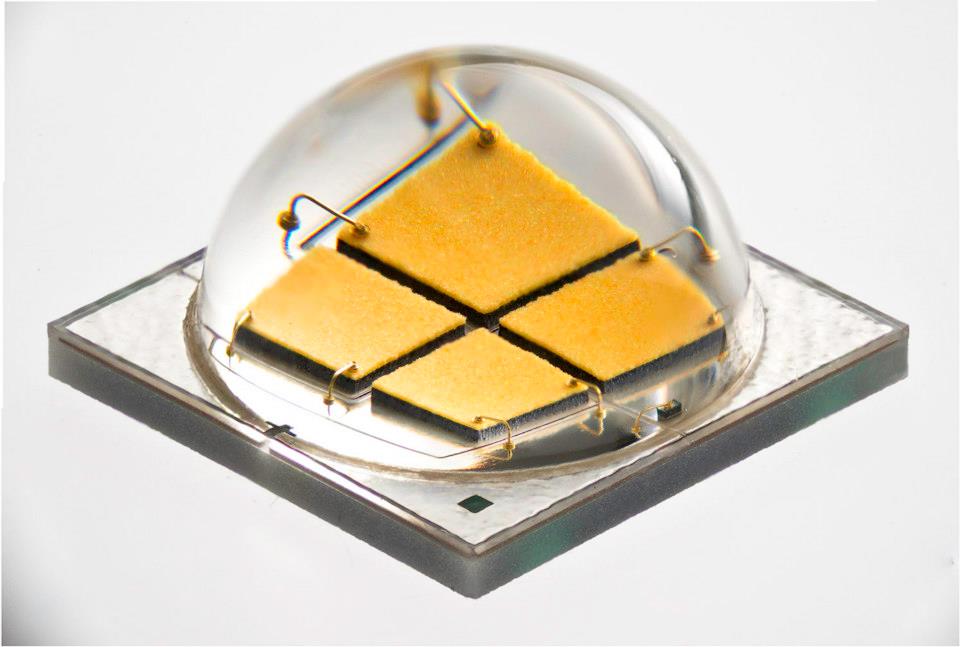The just-announced Cree XLamp MK-R is an all new product that has some impressive specs behind it, one of which being a maximum output of 1769lm @ 85C. Cree just can’t seem to take a break. With the various updates to their workhorse lineup including the XP-E2, XP-G2, and XM-L2 over the last few months, they have had a busy year with new and updated products. Well, it looks like they wanted to slip one more in before the end of the year.
Like all of their new offerings, Cree is building the XLamp MK-R on their silicon carbide technology. It’s a quad-die package with all dies wired in series for a typical forward voltage around 11.7v @ 700mA. This will make it a little easier to get high lumen density without needing a driver that has high current output like you would need for the XM-L. That’s where the basic data from the product announcement really ends.
Upon looking though the announcement, and then comparing the information to the datasheet, things get confusing. Focusing on the few points they make in the announcement, you start to notice the disparity. First up is the 200lm/W claim, which is exciting if true. The XM-L2 was a beast already at 186lm/W, but this takes it to a new level. Problem is, it’s not obvious at what current and with what bin they are making these claims. With their top bins driven at 350mA (efficiency will be greater than at the 700mA where they are binned), the best we could calculate was about 168lm/W, which is a far cry from the 200lm/W claim. Drop it to 250mA (easier data point to extrapolate), and it gets up to 172lm/W, but still falls short, and isn’t a practical drive current for an LED of this type. The 200lm/W figure doesn’t show up until you actually drive the LED at 1W (~100mA). So while they do actually hit 200lm/W, theydid skew how they did it a little in a way that really isn’t practical for those that will actually end up using it.
Another odd thing is the maximum output for the LED. The announcement pegs it at 1769lm @ 1250mA, which is a fantastic number, but from what we can tell, it was based off the J2 bin, and not the K2 bin that is listed later on in the datasheet. The J2 is listed in the ordering codes, and maxes out at 6200K, but
the LED is supposed to be offered up to 8000K at some point, which is where some of the higher bins may start to show up. It’s speculation at this point, but it shows great promise for what this LED could do.
Beyond those two odd points, the rest of the LED details shape up nicely. In regard to thermal resistance, this is the best performing LED that Cree has produced yet. At 1.7C/W, this beats even the brand new XM-L2’s thermal resistance of 2.5C/W. That doesn’t sound like much, but at 15W, that’s only
a 25.5C delta between thermal pad and die temperature. The XM-L2 at 10W would see the same delta, and the venerable old XR-E (8C/W) would be seeing a 24C delta at only 3W! Don’t you love progress?
The rest of the MK-R LED is your standard fare. The package measures 7mmx7mm, with the dome creating a height of 4.8mm. This does mean that it’s not pad compatible with other popular LEDs. Viewing angle comes in at 120 degrees, and the thermal limit is still at 150C.
The MK-R should shape up to be an interesting LED for a variety of applications. For general lighting applications, like MR16 and PAR replacements, it will work nicely with it being easier to drive (higher vf, lower current), and high luminous density. For reefing applications, well, we don’t really have to explain
how well a 2000lm 7mm^2 LED will work, now do we? [Cree]



